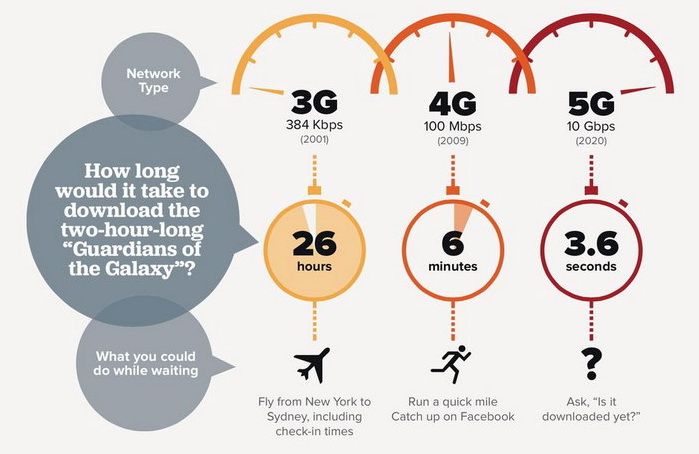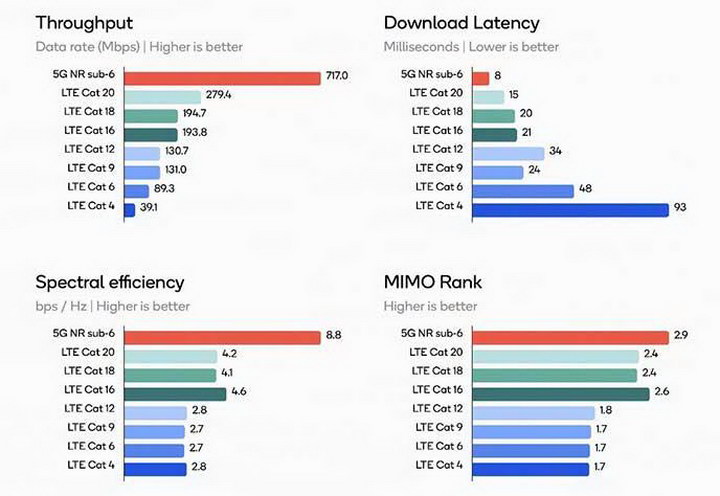There is a lot of enthusiasm for the upcoming 5G mobile networks, especially ones based on the new 5G NR standard. Regular readers of the Display Daily website and Meko’s subscription newsletters should be aware of this – we have published 32 articles discussing 5G since May, 2016.

 Infographic from C-NET showing the relative speeds of 3G, 4G and 5G downloads. (Credit C-NET)
Infographic from C-NET showing the relative speeds of 3G, 4G and 5G downloads. (Credit C-NET)
5G is fast, no one is denying that, and it is the chief selling point for 5G. The peak bit rate for 5G is nominally an astonishing 490 Gbit/s with a nominal download rate for an individual user of 100 Gbit/s. No individual will ever be likely to see that rate, however. The actual download speeds individuals will see is not yet determined experimentally although it is likely to be in the 10 Gbit/s to 20 Gbit/s range, with the C-NET infographic using a “conservative” 10 Gbit/s. Still blazingly fast, compared to 3G or 4G downloads, however. Equally important for some applications such as VR is the response time of the system. That is, when your phone or other mobile device sends a request to the network over 5G, how long does it take for the network to respond? For 5G, this network latency is expected to be about 1mS.
 The two wavelength bands of 5G NR. The exact frequencies used by 5G NR will be determined by the national authorities in each country. (Credit: Qualcomm)
The two wavelength bands of 5G NR. The exact frequencies used by 5G NR will be determined by the national authorities in each country. (Credit: Qualcomm)
One thing about 5G that is often ignored is its current version, 5G NR, is actually a dual-waveband system. The two bands are typically called Sub-6GHz and millimeter wave (mmWave) AKA 28GHz. The sub-6GHz band is relatively long range and still provides speed and latency improvements over 4G at the same radio frequency. But the blindingly fast speeds quoted by 5G enthusiasts come from the mmWave band, not when you are connected via the sub-6GHz band.
 Qualcomm’s simulation of 5G mmWave (28GHz) coverage in San Francisco. Red codes for “Fair Signal” and green for “Excellent Signal.” (Click for Hi-Res version) (Credit: Qualcomm)
Qualcomm’s simulation of 5G mmWave (28GHz) coverage in San Francisco. Red codes for “Fair Signal” and green for “Excellent Signal.” (Click for Hi-Res version) (Credit: Qualcomm)
No one knows how 5G will behave in the real-world, although Qualcomm had done extensive simulations on the system. They simulated the use of the sub-6GHz band in the city of Frankfurt and the mmWave band in the city of San Francisco. These simulations are based on some field test data and, in general, simulations done by mobile wireless companies tend to be fairly accurate – their business depend on the accuracy of their simulations.
In the figure for San Francisco shown above, note only 64.8% of the portion of the city studied actually has mmWave coverage, if mmWave modems are put in the same locations as existing 4G LTE modems. This emphasizes how short range mmWave is: to get full coverage you need to have a modem on essentially every corner. This Qualcomm study is for outdoor coverage and nobody I’ve seen discusses indoor coverage. Since mmWave transmissions are line-of-sight and don’t penetrate buildings, perhaps nobody discusses indoor coverage because there won’t be any.
The 60 GHz version of Wi-Fi (802.11ad) is also mmWave and its inability to penetrate walls is touted as a feature not a bug – networks in adjacent rooms are isolated from each other, even when they are on the same frequency. Due to it’s extreme short range, 1 Km at most, the initial installations of 5G mmWave are expected to be in dense city cores. This is what is driving 5G NR – it is not realistic to install mmWave base stations everywhere, so less dense areas will get the longer range sub-6GHz base stations.
 Qualcomm’s simulation of the 5G sub-6GHz band performance compared to LTE in Frankfurt. (Credit: Qualcomm)
Qualcomm’s simulation of the 5G sub-6GHz band performance compared to LTE in Frankfurt. (Credit: Qualcomm)
In their simulation of the sub-6GHz band performance in Frankfurt, Germany, Qualcomm found 5G outperformed all flavors of LTE for all properties, including speed and latency. Note the spectral efficiency results show that 5G will transmit about 2x more data per unit bandwidth than the three best flavors of 4G LTE and about 3x the data of the four other flavors considered. In a world with billions of wireless devices, bandwidth is going to be limited so this improved spectral efficiency is going to be important, especially in the long range and crowded sub-6GHZ band.
The first 5G NR networks and mobile devices are expected to arrive in 2019, with a more general deployment in 2020 and 2021. The chipmakers, phone makers and service providers are all preparing for this deployment. Chipmakers are expected to have 5G modem chips available in the right time frame for others to develop products for the deployment. A few of the known developments include:
- Qualcomm: According to the company, 18 global operators and 20 leading device makers have selected the Qualcomm Snapdragon X50 5G modem, announced at this years MWC, for the first wave of 5G network trials and consumer devices. This probably puts Qualcomm in the lead, in terms of developing commercial silicon for 5G.
- Samsung: On August 15th, the company announced the Exynos Modem 5100 chip, said to be the industry’s first 5G multi-mode modem that is fully compatible with 3rd Generation Partnership Project (3GPP) Release 15, the most up-to-date standard specification for 5G New Radio (5G-NR). What “New Radio” means is the system is dual-band and supports both sub-6GHz and mmWave. The chip is expected to be available to customers by the end of 2018.
- LG: Sprint and LG confirmed on August 14th that the two companies were working together to produce a 5G phone for Sprint. The expectation is that this phone will use Qualcomm’s X50 5G modem chip although this has not been confirmed by Sprint or LG.
- T-Mobile: The T-Mobile/Sprint merger is in the final stages of approval. The joint Newtmobile.com website emphasizes the importance of 5G to the merged company and to the US and world economies in general. They say “All told mobile technologies accounted for 4.5% of global GDP in 2017 which is equivalent to $3.6 trillion in economic value.”
- Intel: Intel announced on November 16, 2017 substantial advances in its wireless product roadmap to accelerate the adoption of 5G. Highlights include the introduction of the Intel XMM 8000 series, Intel’s first family of 5G NR multi-mode commercial modems, and Intel’s latest LTE modem, the Intel XMM 7660. Intel also announced it has successfully completed a full end-to-end 5G call based on its early 5G silicon, the Intel 5G Modem – a key milestone in its development. Intel first introduced the world to its 5G products at MWC 2017 with the XMM 7560 modem.
- Apple: As usual, Apple has been very closed-mouthed about future products, including 5G versions of the iPhone. Rumor has it, however, that Apple is developing its own version of a 5G chip. They have been feuding with Qualcomm so they may not use the X50 5G modem chip. Even if they are developing their own 5G chip, it may not be ready in time for Apple to have a 2019 5G iPhone so perhaps they will use the Intel chip.
- 5G Device Forerunner Initiative: The 5G Device Forerunner Initiative, established by China Mobile Communication Corporation (CMCC) at MWC 2018, brings together more than 20 of the industry’s most influential and capable chipset manufacturers, component manufacturers and end-solution providers to form a strong industry ecosystem, encouraging 5G device innovation and accelerating 5G device commercialization. To address the project’s goal of delivering mature 5G chipsets, devices, components and instruments that meet China Mobile’s requirements, the large-scale 5G trials rely on Keysight’s suite of industry-first 5G NR network emulation solutions to perform device characterization, design validation and conformance verification. While CMCC is not planning to commercialize it’s 5G network until 2020, it is rolling out hundreds of 5G base stations in 5 Chinese cities to test the technology. At the end of 2017, CMCC had a 4G customer base of 650M subscribers.
This list is nowhere near complete and Lenovo, Nokia, Huawei, Ericsson, ZTE, Cisco and almost everybody else involved in mobile networking is involved in 5G. The initial roll-out of 5G is likely to be 5G NR, especially the sub-6GHz portion of 5G NR. As 5G continues its roll-out, 5G mmWave is likely to be deployed in dense city centers where the bandwidth need is the greatest.
Perhaps the importance of 5G is not in how much it will improve cell phone service or even smartphone service with existing apps. Perhaps the importance of 5G will be the new applications for wireless service made possible by 5G. Several, in particular, may be especially enabled by 5G.
Mobile, streaming VR games and other AR/VR applications may be enabled by 5G networks. (Credit: VRstudios)
First, very low latency is an absolute requirement for streaming Virtual Reality (VR) and is a strong a requirement for streaming Augmented Reality (AR). For VR, the round trip time from the motion sensor in the HMD through the network to the image source and then back from the source through the network to the display on the HMD must be short in order to prevent disorientation and VR sickness. How short?
Nobody is quite sure but it certainly needs to be less than a frame time of 16mS or so. 4G can’t meet his requirement and Wi-Fi has problems, especially when the Wi-Fi network is shared with non-VR users. Today, the best way to reliably meet this latency requirement is to use a dedicated, proprietary wireless network. The 1mS claimed for mmWave is almost certainly fast enough. The 8mS found by Qualcomm for 5G sub-6GHz may be OK, too. This low latency may enable streamed VR, if people actually want streamed VR (and are willing to pay for it).
Another application for 5G is the Internet of Things (IoT). Typically, an individual IoT device does not have a latency requirement of a few milliseconds. Most don’t need high bandwidth either, although systems like surveillance and traffic cameras can chew up bandwidth even though they typically use video compression codecs. This problem will get worse if these cameras are all converted to 4K, where the high resolution provides more advantages than it does in the consumer TV space.
Still, it is not the bandwidth of an individual IoT device that challenges the system but the sheer number of IoT devices that cause the problem. For example, in the first half of 2018, CMCC alone added 155 million IoT smart connections to its network for a year-on-year growth of 47.6%. While there is rarely more than one smartphone active per person, the number of IoT devices can be much higher than the population. Billions and billions of IoT devices are expected in the future and they all need to communicate wirelessly.
Unmanned Aerial Vehicles (UAVs) can be thought of as an extension of the IoT in terms of their need for bandwidth. Like VR, a UAV also has a need for short latency in its control system. CMCC says: “We launched the Innovative Application Research of 5G Unmanned Aerial Vehicles jointly with our partners, exploring the use of UAVs in a wide range of scenarios including patrol, plant protection, surveillance, rescue, logistics and entertainment.”
As can be seen, there is boundless enthusiasm from around the world for 5G networks. First installations are going to be in North America and Asia/Pacific regions, especially the US and China. Europe is expected to lag and won’t see 5G until 2021, which is soon enough and not really much of a lag. To back this enthusiasm up, companies are making large investments in the technology.
Downloading Guardians of the Galaxy in 3.6 seconds is probably not the best justification for the use of a technology that will involve many billions of dollars of investment, especially since these speeds won’t apply to everyone even after the investments are made. Still, there are plenty of other justifications for 5G. We aren’t talking about 3D TV here, we are talking about a technology that almost everyone will use almost every day. At major tradeshows, Wi-Fi and wireless cellular networks can become essentially unusable because the bandwidth just isn’t there to support the attendees and exhibitors. 5G should prevent this from becoming a problem for the general population in the future. –Matthew Brennesholtz

